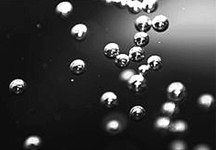| T H E N I H C A T A L Y S T | J U L Y – A U G U S T 2007 |
| | |
Kid's Catalyst: All That Fizz |
by Jennifer White |
Summer's here, and it's a good time to take science outside. We'll need some small plastic bottles of carbonated water that you can buy in a grocery store (how many and how large is up to you, but at least two---and the ones I used were 500 ml), at least three times as many large balloons, a cup of vinegar, a cup of baking soda, two clear cups, and a small nail.
Combining baking soda and vinegar happens to make a great cleaner. And vinegar smells a lot better than bleach, but just like bleach, you sure don't want to get it in your eyes, so be careful.
Before you head outside, think about what we know about carbonated water already. It dances on the tongue, you can watch the bubbles rise in a glass, and if you drink it fast enough . . . well, the carbonation can come back in unexpected ways. But we're going to do a bit more.
Fill one of your clear cups halfway with tap water and the other halfway with carbonated water, and place the two cups in the freezer. We'll come back to them later (but think about how the frozen results might be different). Now, outside we go.
With a small nail, carefully perforate the cap of the carbonated-water bottle you just opened. About 15 holes will do. Stretch the balloon mouth across the top of the cap. This will be our receptacle for the gas that comes from the carbonated water, and preparing it ahead of time allows us to catch as much as possible.
Mark the liquid level of the unopened bottle, and open it carefully. It will start to bubble immediately because the pressure has changed inside the bottle. When you safely have the top off, screw on the other cap with the balloon attached to it. And shake!
It won't take long to see the balloon expand, and if you shake the bottle enough, the balloon will become larger than the bottle itself. Lots of gas in there. But we can do more.
Now let's see what happens when we mix vinegar and baking soda. Place two tablespoons of baking soda and one tablespoon of vinegar (easiest with a funnel) into an empty bottle. Stand back (or you may find yourself covered in vinegary bubbles), get your balloon ready, and repeat the same procedure.
After you've cleaned up a bit, come back inside and look at the frozen water versus the frozen carbonated water that you placed in the freezer about an hour ago. You'll see a layer on top of the frozen carbonated water, but what is it? Thaw the glasses and note the water level, and also how fizzy the formerly frozen frothy water is. (Say that one quickly!)
If you have any leftover bottles of carbonated water, freeze them (unopened), along with another bottle full of tap water. It won't explode in the freezer, as cans can, because the bottle is plastic, but after these two are frozen you will see just how much frozen water expands.
Have fun with your carbonated water, see the mountain of bubbles created with vinegar and baking soda, and enjoy the warm weather!
